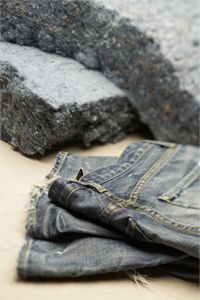When you're finished with your favorite pair of jeans, what do you do with them? If you're like most people, you give them to a younger family member, donate them to a local charity, such as Goodwill, sell them on consignment or throw them away. Unfortunately, this last option is one we all choose too often -- each year, almost 24 billion pounds (nearly 11 million metric tons) of clothing including jeans end up in landfills, where they can remain, depending on the material used and the conditions in the trash heap, for years. That's not a very green way to handle your blues [source: Levi Strauss & Co.].
Luckily, there's a new use for old jeans that protects our planet and improves living conditions inside your home. It's known as denim insulation, and it's been finding its way into some high-profile buildings in recent months. For example, the California Academy of Sciences, a museum that stands as the very symbol of sustainable architecture, used denim for 68 percent of its insulation needs [source: California Academy of Sciences].
Advertisement
But what exactly is denim insulation? Is it, literally, blue jeans turned into batting, or pieces of thermal insulation? The short answer is yes, although it's slightly more complicated than that. A company by the name of Bonded Logic developed the material over 35 years and owns patents to the manufacturing process. The end product of that process is UltraTouch Insulation, which contains 80 percent post-consumer recycled natural fibers -- fibers derived directly from your stone-washed, acid-washed or perhaps never-washed denim. We'd be remiss if we didn't mention that other companies, such as Applegate Insulation and Le Relais, for instance, have dabbled in denim insulation and will continue to do so as this insulation trend grows. In this article, we focused on Bonded's product simply due to its longevity in the space.
Cynics worried about greenwashing might wonder if denim insulation is just another product trying to profit from the environmental movement. But denim has all of the properties of a good insulator -- its lower density reduces its thermal conductivity, which means it minimizes the transfer of heat from one material (your home) to another (the air around your home). As a result, denim insulation rivals fiberglass in its ability to serve as a barrier to both heat and sound.
Of course, you can't simply take off your jeans and stuff them into your walls, attics or crawl spaces. They must be recycled and prepared in a specific process before they earn the title of insulation. Let's take a trip to the cotton fields, where denim begins its rugged life.
